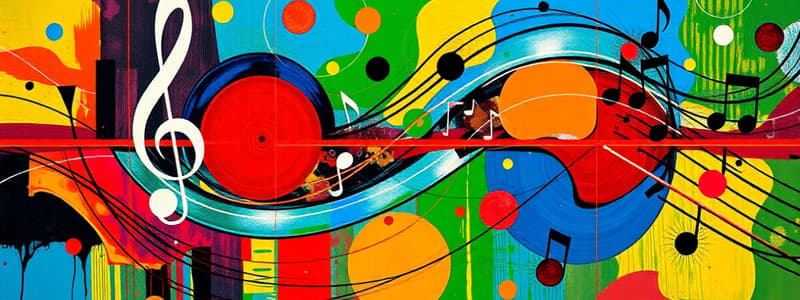Podcast
Questions and Answers
What is the primary function of rhythm in music?
What is the primary function of rhythm in music?
- It defines the quality or tone color of music.
- It creates harmony between different instruments.
- It situates music in time and provides its pulse. (correct)
- It determines the loudness or softness of a piece.
Which term describes two or more tones played simultaneously in music?
Which term describes two or more tones played simultaneously in music?
- Texture
- Timbre
- Melody
- Chord (correct)
What distinguishes disjunct melodies from conjunct melodies?
What distinguishes disjunct melodies from conjunct melodies?
- Disjunct melodies are characterized by jumps in pitch, while conjunct flows smoothly. (correct)
- Disjunct melodies are smooth, while conjunct melodies are jumpy.
- Disjunct melodies are never harmonized, whereas conjunct always are.
- Disjunct melodies have no identifiable pitch, whereas conjunct do.
What does timbre refer to in music?
What does timbre refer to in music?
Which type of texture includes two or more different melodic lines?
Which type of texture includes two or more different melodic lines?
How is melody described in musical terms?
How is melody described in musical terms?
What is a triad in music?
What is a triad in music?
Which element of auditory art is primarily responsible for tonal variations in sound?
Which element of auditory art is primarily responsible for tonal variations in sound?
Flashcards
Rhythm
Rhythm
The pulse or flow of music through time, often associated with beats and tempo.
Beat
Beat
The basic unit of music, like a pulsation. A beat is like a single click in a rhythm.
Tempo
Tempo
The speed of the music, measured in beats per minute.
Melody
Melody
Signup and view all the flashcards
Pitch
Pitch
Signup and view all the flashcards
Harmony
Harmony
Signup and view all the flashcards
Timbre
Timbre
Signup and view all the flashcards
Texture
Texture
Signup and view all the flashcards
Study Notes
Elements of Auditory Art
- Music is a form of auditory art, capable of transcending language and cultural barriers.
- Different demographics, groups, and individuals have varying musical preferences.
- To evaluate music, listeners often consider its elements, similar to how visual art is judged.
Common Elements of Auditory Art: Rhythm
- Rhythm is often associated with beats and tempo.
- It occurs within time.
- Rhythm is considered the pulse of music.
- It is the flow of music over time.
Common Elements of Auditory Art: Other Elements
- Beat: The basic unit of music (pulsation).
- Tempo: The speed of beats per second.
- Meter: A recognizable recurring pattern.
Common Tempo Markings
- Tempo markings provide a way to describe the speed of music.
- Markings vary in terms of speed from very slow to exceptionally fast.
- Examples of tempo markings include: Grave (very slow), Largo (slow and broad), Lento (slow), Adagio (slow with expression), Andante ("walking" speed), Moderato (moderately fast), Allegretto (moderately fast), Allegro (fast), Allegro Moderato (slightly slower than allegro), Vivace (fast and lightly), Allegro Vivace (very fast), Presto (exceptionally fast).
Dynamics
- Dynamics refer to the loudness or softness of sound in music.
- Various terms and symbols are used to specify dynamics.
Musical Terms and Symbols for Dynamics
- pianississimo (ppp): very, very soft
- pianissimo (pp): very soft
- piano (p): soft
- mezzo piano (mp): moderately soft
- mezzo forte (mf): moderately loud
- forte (f): loud
- fortissimo (ff): very loud
- fortississimo (fff): very, very loud
Melody
- Melody refers to the linear representation of pitch (horizontal presentation of pitch).
- It solely refers to the musical notation.
- When reading a melody, it is performed in a left-to-right sequence.
Characteristics of Melody
- Pitch: Highness or lowness of sound.
- Conjunct: Smoothness of melody
- Disjunct: Ragged or jumpy melody.
Harmony
- Harmony refers to the linear representation of pitch (horizontal presentation of pitch).
- It combines elements of dissonance (harsh-sounding) and consonance (smooth-sounding).
- A chord is made up of two or more tones/notes played simultaneously.
- A triad is a chord comprised of three tones/notes.
Timbre
- Timbre, also known as tone color, is a quality that distinguishes a voice or instrument from another.
- Timbre differentiates instruments based on unique characteristics.
- Examples include Soprano, Alto, Tenor, Bass, Orchestral Instruments, and Rondalla Instruments.
Texture
- Texture, in the context of music, relates to the number of melodic lines used and their interplay. It can involve thickness or thinness, lightness or heaviness.
Types of Melodies
- Monophonic: A single melodic line.
- Polyphonic: Multiple independent melodic lines combined.
- Homophonic: Multiple melodic lines playing the same melody simultaneously.
- Heterophonic: Multiple melodic lines playing variations of the same melody simultaneously.
Studying That Suits You
Use AI to generate personalized quizzes and flashcards to suit your learning preferences.




